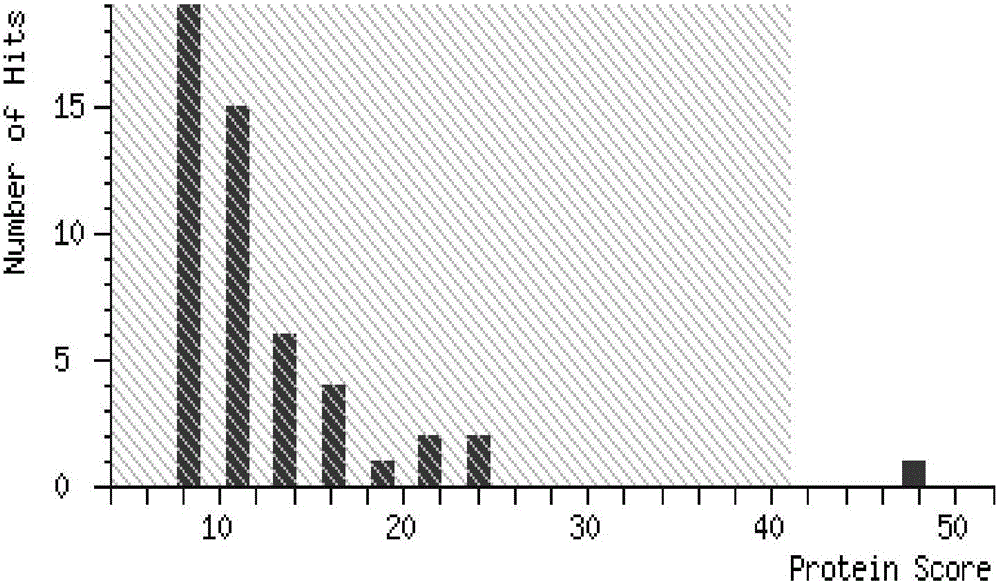Portunus trituberculatus reovirus receptor, screening method and application thereof
A technology for the portunus trituratus and reovirus, which is applied in the field of biology, can solve the problems such as the undisclosed portunus trituratus reovirus and the like, and achieves the effect of expanding the scope
- Summary
- Abstract
- Description
- Claims
- Application Information
AI Technical Summary
Problems solved by technology
Method used
Image
Examples
specific Embodiment 1
[0026] Screening of Reovirus Receptor in Portunus trituberculatus by Western Blot
[0027] 1. Purification of Portunus trituberculatus reovirus (SCRV)
[0028]Take the portunus trituberculatus that died from the infection of the virus, dissect the internal organs on ice, weigh them, and add them to the pre-ice-bathed 1mM phenylmethylsulfonyl fluoride (PMSF) TNE 2 Homogenize in buffer solution, centrifuge the homogenate at 4°C, 8000g for 20min, and use TNE containing 1mM PMSF for precipitation 2 After resuspending the homogenate in the buffer, centrifuge again at 4°C, 8000g for 20min, combine the supernatant obtained from the two centrifugations, centrifuge the supernatant at 4°C, 6000g for 10min, take the supernatant and centrifuge at 4°C, 38000g for 1.5h , with pre-cooled TM 2 The loose part of the upper layer of the precipitate was washed with the buffer solution, and the solid white precipitate part of the lower layer was washed with pre-cooled TM containing 1mM PMSF 2 ...
specific Embodiment 2
[0039] Preparation of Receptor Antibody of Portunus trituberculatus Reovirus (SCRV)
[0040] Homogenate the above portunus trituberculatus reovirus receptor protein from 8% SDS-PAGE gel, suspend with 0.9% sodium chloride, mix the receptor protein and complete Freund's adjuvant in equal volumes, and fully emulsify Afterwards, the mice were injected subcutaneously for basic immunization, and the immunization dose for each mouse was 10-20 μg / mL. After 15 days, the portunus trituberculatus reovirus receptor protein and Freund's incomplete adjuvant were mixed in equal volumes, fully After emulsification, the mice were injected subcutaneously for booster immunization. The immunization dose for each mouse was 8-15 μg / mL. The booster immunization was repeated 3 times with an interval of 7-10 days. After the last immunization, the mice were given Pick up the eyeball to take blood, put the blood at room temperature for 1 hour, transfer it to 4°C and let it stand for 3-5 hours, gently fi...
specific Embodiment 3
[0041] Verification of the Binding of Portunus trituberculatus Reovirus (SCRV) to SCRV Receptor by Co-immunoprecipitation Technique
[0042] Add 800ul of Portunus trituberculatus gill membrane protein extract and 30ul of Portunus trituberculatus reovirus antigen freshly prepared in Specific Example 1 into a centrifuge tube, shake slowly at 4°C for 8 hours, then add 10ul of mouse anti-receptor protein antibody, Anti-turtle systemic septicemia spheroid virus yolk antibody was used as a negative control, and incubated overnight at 4°C. Take 60ul of protein A / G agarose (Santa Cruz Biotechnology Company, sc-2003) and mix thoroughly by inverting, then add to a centrifuge tube and shake slowly at 4°C for 3h, add 1ml of high-salt NETN buffer, at 4°C, 3000rpm Centrifuge, take the precipitate and repeat the centrifugation operation 4 times for washing, finally add 1ml of NETN buffer, centrifuge at 4°C, 3000rpm, take the precipitate and add 30ul protein loading buffer, cook in boiling wa...
PUM
 Login to View More
Login to View More Abstract
Description
Claims
Application Information
 Login to View More
Login to View More - R&D
- Intellectual Property
- Life Sciences
- Materials
- Tech Scout
- Unparalleled Data Quality
- Higher Quality Content
- 60% Fewer Hallucinations
Browse by: Latest US Patents, China's latest patents, Technical Efficacy Thesaurus, Application Domain, Technology Topic, Popular Technical Reports.
© 2025 PatSnap. All rights reserved.Legal|Privacy policy|Modern Slavery Act Transparency Statement|Sitemap|About US| Contact US: help@patsnap.com



